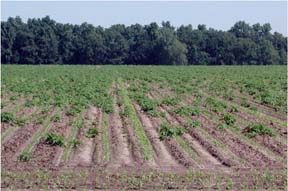Volunteer potatoes
Editor’s note: This article is from the archives of the MSU Crop Advisory Team Alerts. Check the label of any pesticide referenced to ensure your use is included.
Volunteer potatoes are a concern for potato producers every season, however, last season late blight was a major concern throughout the state making volunteer control an even greater issue in 2010. Timely management and vine removal was necessary last season to avoid widespread infestation. Wet weather, poor harvest conditions, and management practices to stop the spread of late blight combined with cull piles resulted in many tubers being left in the field heading into the winter. The snow cover this past winter was sufficient enough to insulate the ground, reducing the number of tubers exposed to freezing temperatures throughout the winter and subsequently increasing the number of volunteers this spring. Fatality of meristematic tissue on potato tubers of the most temperature-tolerant varieties requires exposure to temperature less than 26°F for more than 72 hours. These temperatures are rarely reached in Michigan soils (See Table 1). Consequently, volunteer potato tubers surviving the winter to develop and grow in the spring have been common since 1995 when we started monitoring at MSU. These tubers can harbor inoculum of various diseases, the most important of which is late blight. The pathogen that causes late blight is an obligate pathogen on tubers, and so far the overwinter resting spore has not been found in Michigan. This soil spore is rarely found in nature in North America.
Table 1. Soil temperature at 4 inches depth in Entrican (Montcalm County) from November 2009 to April 2010
|
Month
|
Average soil temperature (oF)
|
St. deviation
|
Hours below 26oF
|
|
11/1-30/09
|
39.8
|
3.24
|
0
|
|
12/1-31/09
|
30.4
|
1.99
|
0
|
|
1/1-31/10
|
27.9
|
0.35
|
2
|
|
2/1-28/10
|
39.8
|
0.56
|
0
|
|
3/1-31/10
|
39.8
|
5.57
|
0
|
|
4/1-30/10
|
39.8
|
4.59
|
0
|
Potato tubers are returned to the soil after harvest the previous year. Populations can vary, but up to 100,000 plants/A have been reported; the planting rate for potatoes is about 20,000 plants/A. Many areas are reporting volunteers emerging, and it is critical to remove these as soon as possible to reduce the opportunity for disease.
There are several options for suppression and control of volunteer potato that will significantly reduce the number of daughter tubers per plant; however, there currently are no herbicides available that will completely control volunteer potato with one application. Michigan State University research has evaluated the effectiveness of several different postemergence options for control of volunteer potatoes in corn. Herbicide treatments were applied when volunteer potatoes were between four and six inches tall. From this research, several products were identified, which provide good control including: Callisto at 3 fl oz/A; Laudis at 3 fl oz/A; Impact at 0.5 fl oz/A; and Status at 5 oz/A. Control with all products was improved when atrazine at 0.5 or 1.0 lb/A was included in the application. These products provided 80 to 90 percent control when applied alone, but control increased to 96 percent or better where atrazine was included. These treatments also stopped daughter tuber production, reducing the risk of transmitting disease to the next year’s potato crop. Rotational crop sensitivity should be considered when using these herbicides, especially sugar beets and dry beans. Herbicide rotation restrictions can be found on pages 147-150 in 2010 Weed Control Guide for Field Crops.
Good suppression of volunteer potatoes in the MSU trial was also obtained with Starane at 0.67 pt/A + atrazine 1.0 lb/A. Starane has a similar mode of action as Status, Clarity, Stinger and 2,4-D and has been used in small grains for a number of years with a recent registration for use in field corn. It is important to remember to be cautious when using this herbicide around sensitive broadleaf crops, such as soybeans, sugar beets, grapes, dry beans, etc. Starane is labeled for preplant and postemergence applications up to V5 (5 fully exposed leaf collars) corn at 0.67 pt/A for suppression of volunteer potatoes.
Something to consider
Corn inbreds are sensitive to many herbicides labeled in field corn. Consult the seed company agronomist before using any herbicides for weed control on inbreds. The only treatments that can be applied to seed corn that provided good suppression of volunteer potatoes were a HPPD inhibitor alone and + atrazine. Corn inbreds vary in their sensitivity to herbicides including HPPD inhibitors, so it is important to consult the seed company on their inbred tolerances before making an application.



 Print
Print Email
Email




